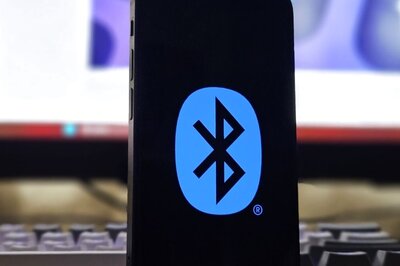
views
File Menu
Click the File menu in the upper-left corner. On Mac, click on the Outlook menu in the upper-left corner instead.
Click Exit at the bottom of the menu. On Mac, click Quit Outlook at the bottom of the menu instead.
Open Outlook once it's closed. If Outlook is pinned to your taskbar (Windows) or dock (Mac), click the icon to open the application again. Otherwise, open Outlook from the desktop or search for it using the taskbar search bar (Windows) or Spotlight (Mac).
Keyboard Shortcut
Make sure Outlook is your active window. You can use a keyboard shortcut to close Outlook, but in order for it to work, Outlook must be your active window. The easiest way to make Outlook your active window is to click on the window or the Outlook app icon in your taskbar (Windows) or dock (Mac).
Press Alt+F4 (Windows) or ⌥ Option+⌘ Cmd+Esc (Mac). Outlook will immediately close. If Outlook doesn't close, try the keyboard shortcut again, pressing each button once at a time but in quick succession.
Open Outlook once it's closed. If Outlook is pinned to your taskbar (Windows) or dock (Mac), click the icon to open the application again. Otherwise, open Outlook from the desktop or search for it using the taskbar search bar (Windows) or Spotlight (Mac).
Task Manager (Windows)
Open Task Manager. There are a few ways you can do this: Right click the Windows button (in the bottom-left corner) and select Task Manager. Right click the taskbar and select Task Manager. Press Ctrl + Alt + Del and select Task Manager.
Select Microsoft Outlook from the list. While you can use the Task Manager to close Microsoft Outlook at any time, one of the most common times to use it is when Outlook is unresponsive.
Click End task to fully close the app. Outlook will close immediately once you click the End task button.
Open Outlook once it's closed. If Outlook is pinned to your taskbar, click the icon to open the application again. Otherwise, open Outlook from the desktop or search for it using the taskbar search bar.
Force Quit (Mac)
Click the Apple icon in the upper-left corner. It's the menu button that is directly to the left of the Outlook menu button.
Click on Force Quit. A window will pop up showing you all the programs and processes that are currently running on your computer.
Select Microsoft Outlook from the list. While you can use Force Quit to close Microsoft Outlook at any time, one of the most common times to use it is when Outlook is unresponsive.
Click Force Quit to fully close the app. Outlook will close immediately once you click the Force Quit button.
Open Outlook once it's closed. If Outlook is pinned to your dock, click the icon to open the application again. Otherwise, open Outlook from the desktop or search for it using Spotlight.
iPhone/iPad App
Open the App Switcher. How you do this depends on what model of iPhone or iPad you have: Devices with a Home button: Double-click the Home button Devices without a Home button: Swipe up from the bottom edge of the screen, then pause near the center of the screen
Find the Microsoft Outlook app. Swipe left and right to scroll through your open apps until you find Outlook.
Swipe up on Outlook to close it. Once you swipe up on the Outlook app, it will disappear. The app is now closed.
Exit the App Switcher. You can do this by pressing the Home button again (if you have one) or by tapping on your blurred Home screen behind the open apps.
Open Microsoft Outlook again. If Outlook is on your Home screen or dock, tap it to open it. Otherwise, scroll to your App Library, search for Outlook, and tap the Outlook app.
Android App
Tap on the Overview button. It's the button with three vertical lines in the lower-left or lower-right corner of your screen. You may have to long press the Overview button, depending on your Android model. If you enabled navigation gestures, you can open the Overview menu by swiping up from the bottom-left of your screen and holding until Overview opens.
Find the Microsoft Outlook app. Swipe left and right to scroll through your open apps until you find Outlook.
Swipe up on Outlook to close it. Once you swipe up on the Outlook app, it will disappear. The app is now closed.
Tap the Home button to return to your home screen. It's the circular button in the middle of your navigation bar. If you enabled navigation gestures, you can go back home by swiping up from the bottom of the screen.
Open Microsoft Outlook again. Swipe until you get to the screen that Outlook is on and tap it to open it.
Web Version
Close the Outlook tab. You can also opt to close your web browser entirely if you prefer. If so, make sure you close the browser fully by using the File/application menu (in the upper-left corner of the screen) or by using Task Manager (Windows)/Force Quit (Mac). If you exit out of your browser, make sure to open it up again before continuing.
Open a new tab. In most web browsers, you can do this by clicking the "+" button next to your currently open tab. You can also open the browser's menu and select the button that says "new tab" (or something similar). You can also open a new window, if you prefer, or navigate to Outlook in the tab that you're currently in.
Navigate to the web version of Outlook and sign in. Go to Outlook's webpage and click Sign in, then log in with your credentials.
Run Command (Windows)
Press ⊞ Win+R to open Run. Alternatively, you can search for "Run" in the taskbar search bar, or right-click the Windows button (in the lower-left corner) and select Run.
Type outlook.exe /resetnavpane in the Run window. Press Enter to run the command, or click the OK button. This command resets Outlook's navigation pane, which will restart Outlook. If you run this command when Outlook is open, it will open a second Outlook window. For best results, run this command with Outlook closed.


















Comments
0 comment